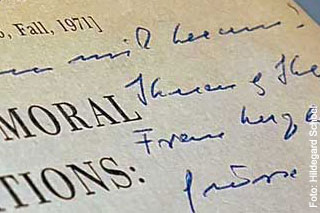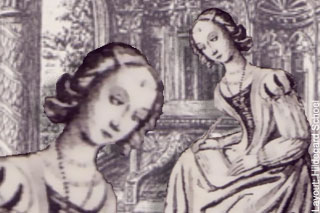Collections tells stories
News, interesting facts and stories from over 80 collection portals. We regularly report on them here.
April 2025 – Provenienzforschung in der USB Köln
Pünktlich zum Tag der Provenienzforschung 2025 geben unsere Kolleg*innen Svenja Berkensträter und Arne Schiffler mit ihren Beiträgen in “RETOUR - Freier Blog für Provenienzforschende” Einblicke in aktuelle USB-Projekte zur Erforschung der Herkunft historischer Buchbestände und machen deutlich, dass Provenienzforschung zur Wiederentdeckung kulturellen Erbes beiträgt.
Wiederbelebung historischer Sammlungen in der USB Köln
Die Provenienzforschung an der USB Köln begann mit der Suche nach NS-Raubgut – und förderte seither bewegende Geschichten und bedeutende Sammlungen zutage, wie etwa die der Schwestern Elise und Helene Richter. Heute steht die Rekonstruktion historischer Klosterbibliotheken im Fokus. Projekte wie zur Kölner Jesuitenbibliothek oder zu mittelalterlichen Inkunabeln zeigen, wie Bücher vergangener Jahrhunderte digital wiederbelebt und mit ihrer Herkunftsgeschichte verknüpft werden – ein wichtiger Einblick in alte Wissenswelten.
Zum Beitrag von Svenja Berkensträter>>
Provenienzforschung in der Historischen Stadtbibliothek Köln
Die Historische Stadtbibliothek Köln, seit 1920 Teil der USB, entstand aus zahlreichen Bücherspenden des wohlhabenden Kölner Bürgertums im späten 19. Jahrhundert. Ihre Bestände spiegeln vor allem literarische, historische und theologische Interessen wider. Seit 2019 werden rund 400.000 Bände systematisch auf Provenienzmerkmale untersucht. Ziel ist die Rekonstruktion ursprünglicher Sammlungen und Nachlässe – ein aufwendiges Projekt mit großem Potenzial für die Forschung zur Wissens- und Kulturgeschichte Kölns.
Provenienzen erforschen, verzeichnen, restituieren
In der Provenienzforschung versuchen wir die Herkunft und die wechselnden Besitzverhältnisse unseres Altbestandes aufzuklären, überregional zu verzeichnen und im Fall von NS-Raubgut zu restituieren.
Informationen zur Provenienzforschung in der Universitäts- und Stadtbibliothek Köln >>
Februar 2025 - Neues Sammlungsportal: SAMMLUNG KOCHBÜCHER
Kulturgut Kochbuch
Im Jahr 2013 haben wir rund 150 antiquarische Kochbücher der Kölner Buchhandlung BuchGourmet erworben. Darüber hinaus besitzen wir bereits seit Jahrzehnten Kochbücher mit regionalem Hintergrund, darunter Werke mit Bezug zum Rheinland oder aus anderen Sammlungen, wie z.B. der Sammlung Islandica oder dem Sammelschwerpunkt Belgien/Luxemburg. Ein besonderes Highlight ist das älteste erhaltene Kochlehrbuch, Marx Rumpolts „New Kochbuch“ von 1581, das zur Syndikatsbibliothek, der Kölner Ratsbibliothek von 1602, gehört.
Die historische Kochbuchsammlung wird als virtuelle Sammlung zusammengeführt und kontinuierlich durch gezielte Erwerbungen sowie Schenkungen ergänzt. Aktuell sind 300 Titel im Portal recherchierbar. Da Kochbücher wertvolle Einblicke in die Wirtschafts- und Sozialgeschichte bieten, ist ihr Erhalt von besonderer Bedeutung.
Sammlungen der Rheinischen Abteilung >>
Januar 2025 - Historische Zeitungen online im Zeitungsportal NRW
17 Millionen Seiten sind nun online durchsuchbar!
Das Zeitungsportal NRW zeit.punkt NRW stellt historische Lokalzeitungen aus den Jahren 1801-1945 online zur Verfügung. Insgesamt enthält das Portal fast 20 Millionen Seiten, davon sind bereits über 17 Millionen mittels optischer Texterkennung durchsuchbar. Ab 2022 werden schließlich alle Zeitungstitel nach und nach auch im Nationalen Zeitungsportal der Deutschen Digitalen Bibliothek nachgewiesen.
Zeitungen der USB Köln im Zeitungsportal NRW
Aus unserem Bestand wurden 686 Mikrofilme im Landesarchivzentrum Brauweiler digitalisiert. Zusätzlich haben wir in unserem Digitalisierungszentrum 46 Zeitungstitel digitalisiert und über Verlinkungen in zeit.punkt NRW zugänglich gemacht.
Kölnische Zeitung von 1803 -1945
Besonders wichtig und gerne genutzt wird die Kölnische Zeitung: Insgesamt haben neun Institutionen dazu ihre Bestände zusammengetragen. In der USB Köln entstanden etwa 235.000 Scans von insgesamt ca. 420.000 Seiten.
Am Beispiel der Kölnischen Zeitung zeigt sich die Informationstiefe, mit der historische Zeitungen im Portal präsentiert werden: Die ausführliche Beschreibung enthält Charakterisierung, Geschichte, Entwicklung und politische Ausrichtung der Zeitung sowie Angaben zu Erscheinungsweise, Auflage, Beilagen und eine Literaturliste mit ausgewählten Publikationen über die Zeitung.
Beschreibung der Kölnischen Zeitung in zeitpunkt.nrw >>
Die Projektarbeit zum Zeitungsportal NRW wird von den Universitäts- und Landesbibliotheken Bonn, Münster und Düsseldorf, dem Hochschulbibliothekszentrum des Landes Nordrhein-Westfalen und dem LVR-Archivberatungs- und Fortbildungszentrum durchgeführt. Insgesamt kooperieren 116 Archive und Bibliotheken in dem vom Land Nordrhein-Westfalen geförderten Projekt.
Ab Januar 2025 - monatliche #OneBookShows
Ab 2025 zeigen wir im Foyer jeden Monat ein Buchobjekt aus unseren Sammlungen. Mal sind es Unikate, mal Beispiele aus der Massenproduktion, die wir mit Hintergrundinformationen zur Entstehungsgeschichte zeigen, inklusive der Sammlungsportale, aus denen die Bücher stammen.



